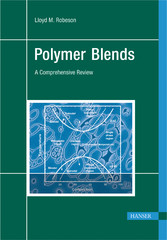Lloyd M. Robeson
Polymer Blends
A Comprehensive Review
Preface
8
Contents
10
1 Introduction
14
1.1 General Overview
14
1.2 Historical Review
16
1.3 Overviewof the Book
18
1.4 Definitions
19
References
20
2 Fundamentals of Polymer Blends
24
2.1 Thermodynamic Relationships
24
2.1.1 Combinatorial Entropy ofMixing
27
2.1.2 Enthalpy ofMixing
29
2.1.3 Flory-Huggins Theory
30
2.1.4 Equation of State Theories
32
2.2 Phase Behavior
37
2.2.1 Miscible versus Immiscible Blends
37
2.2.2 Spinodal Decomposition and Nucleation and Growth
40
2.3 Solubility Parameter Concepts
43
2.4 Specific Interactions
48
2.4.1 Hydrogen Bonding Interactions
48
2.4.2 Dipole-Dipole Interactions
53
2.4.3 Ion-Dipole and Ion-Ion Interactions
54
2.4.4 Additional Specific Interactions
55
2.5 Mean Field Theory and Intramolecular Repulsion Concepts
55
2.6 Association Model
61
2.7 Interfacial Aspects
62
2.8 AdditionalMethods of Predicting Polymer Phase Behavior
67
References
69
3 CompatibilizationMethods
78
3.1 Introduction of Specific Interacting Groups
79
3.2 In-Situ Polymerization Compatibilization
80
3.3 Ternary Polymer Addition (Nonreactive)
83
3.4 Reactive Compatibilization
86
3.4.1 Reactive Extrusion Compatibilization (Single Pass Extrusion)
94
3.5 Interpenetrating Polymer Networks
97
3.6 Crosslinking between Phases
100
3.7 Block Copolymer Addition
101
3.8 Polymer-Polymer Reactions
105
3.9 AdditionalMethods of Compatibilization
109
References
111
4 Types of Polymer Blends
122
4.1 Methods of Blend Preparation/Processing
122
4.2 Elastomer Blends
125
4.3 Elastomer (Low T)g-HighModulus (High Tg) Impact Modified Polymer Blends
131
4.4 Polymer Blends Containing Crystalline Polymers
137
4.4.1 Crystalline Polymer-Amorphous Polymer Blends
137
4.4.2 Crystalline-CrystallinePolymer Blends
143
4.4.3 Isomorphic Polymer Blends
148
4.5 Polyolefin Blends
150
4.6 Engineering Polymer Blends
154
4.6.1 Poly(PhenyleneOxide) Based Blends
154
4.6.2 Aromatic Polycarbonate Based Blends
157
4.6.3 Polyarylate Based Blends
160
4.6.4 Poly(Aryl Ether Ketone) Based Blends
161
4.6.5 Aromatic PolysulfoneBased Blends
163
4.6.6 Polyamide Based Blends
163
4.6.7 Polyimide Based Polymer Blends
164
4.6.8 Poly(Phenylene Sulfide) Based Blends
166
4.6.9 Miscellaneous Engineering Polymer Blends
166
4.7 Emulsion Blends
167
4.8 Liquid Crystalline Polymer Blends and Molecular Composites
172
4.8.1 Liquid Crystalline Polymer Blends
172
4.8.2 Molecular Composites
177
4.9 Polymer Blends Containing Block Copolymers
179
4.10 Blends Based on Polystyrene and Styrene Copolymers
185
4.11 Blends Based on PMMA and (Meth)Acrylate Copolymers
192
4.12 Blends Based on PVC
195
4.13 Blends Involving Thermosetting Polymers
200
4.14 Water SolublePolymer Blends/PolyelectrolyteComplexes
204
4.15 Biodegradable and Natural Polymer Based Blends
211
4.15.1 Biodegradable Polymer Blends
211
4.15.2 Natural Polymer Blends
213
4.16 Miscellaneous Blends
215
4.16.1 Recycled Polymer Blends
215
4.16.2 Conductive Polymer Blends
217
4.16.3 Ternary Polymer Blends
220
4.16.4 Miscellaneous Polymer Blends
222
4.17 Polymer Blend Composites
223
References
226
5 Characterization of Polymer Blends
266
5.1 Glass Transition
266
5.2 DynamicMechanical Characterization
270
5.3 CalorimetricMethods
275
5.4 Dielectric Characterization
279
5.5 Morphology/Microscopy
284
5.5.1 OpticalMicroscopy
284
5.5.2 Transmission ElectronMicroscopy (TEM)
286
5.5.3 Scanning Electron Microscopy (SEM)
289
5.5.4 Atomic Force Microscopy (AFM)
291
5.5.5 Scanning TunnelingMicroscopy
293
5.5.6 X-RayMicroscopy
293
5.6 Scattering Methods: Light,X-Ray,Neutron
293
5.6.1 Light Scattering
295
5.6.2 X-Ray Scattering
297
5.6.3 Neutron Scattering
299
5.6.4 Neutron Reflectivity
302
5.6.5 Neutron Spin Echo Spectroscopy
302
5.6.6 Other ScatteringMethods
302
5.7 Nuclear Magnetic Resonance
303
5.8 Spectroscopic Methods
309
5.8.1 Infrared Spectroscopy
309
5.8.2 UV-Visible Spectroscopy
314
5.8.3 Raman Spectroscopy
314
5.8.4 Fluorescence Spectroscopy:Non-Radiative Energy Transfer and Excimer Fluorescence
315
5.8.5 X-Ray Photoelectron Spectroscopy and Secondary Ion Mass Spectroscopy
318
5.9 Vapor Sorption and Solvent Probe Techniques
320
5.10 Positron Annihilation Spectroscopy
323
5.11 Characterization of Interfacial Properties
325
5.12 Miscellaneous Characterization Techniques
328
References
330
6 Properties of Polymer Blends
346
6.1 Mechanical Properties
346
6.2 Thermal Properties
364
6.2.1 Crystallinity
364
6.2.2 Thermal Stability
371
6.3 Transport Properties
371
6.3.1 Diffusion and Permeability of Gases
371
6.3.2 Transport inMiscible Blends
372
6.3.3 Transport in Phase Separated Blends
373
6.3.4 Thermal Conductivity
377
6.4 Electrical Properties
377
6.5 Rheology and Processing of Polymer Blends
380
6.5.1 Rheology of Phase Separated Blends
383
References
387
7 Commercial Applications of Polymer Blends
398
7.1 Commercial Elastomer Blends
398
7.2 Commercial Polyolefin Blends
401
7.3 Commercial Engineering Polymer Blends
403
7.4 Impact Modified Blends
410
7.5 PVC Commercial Blends
412
7.6 Commercial Polymer Blends Comprising Styrenic Polymers
413
7.7 Commercial Polymer Blends Based on Acrylate Containing Polymers
414
7.8 Commercial Applications of Emulsion Blends
414
7.9 Miscellaneous Commercial Blends
416
7.10 Miscellaneous Patent Examples Suggesting Commercial Potential
419
References
420
8 Emerging Technology Involving Polymer Blends
428
8.1 Nanotechnology
428
8.1.1 Polymer/Polymer/Nanoparticle Composites
429
8.2 Electronics/Optoelectronics
430
8.2.1 Photovoltaic Applications
431
8.2.2 Light Emitting Diode Applications
433
8.2.3 Electrochromic Applications
434
8.2.4 Additional Electronics Applications
435
8.3 Electrically Conductive Polymers and Blends
436
8.4 Application of Supercritical Fluids in Polymer Blends
438
8.5 LithiumBattery Applications
439
8.6 Fuel Cell Materials Opportunities
441
8.7 Biomaterials/Biotechnology
443
8.8 Miscellaneous Applications of Polymer BlendTechnology in Emerging Technologies
446
References
446
Appendix
452
Appendix 1
452
Abbreviations
452
Appendix 2
457
Acronyms
457
Appendix 3
458
Index
464
© 2009-2024 ciando GmbH
 Zu Hanser-Fachbuch.de
Zu Hanser-Fachbuch.de
 Warenkorb
Warenkorb
